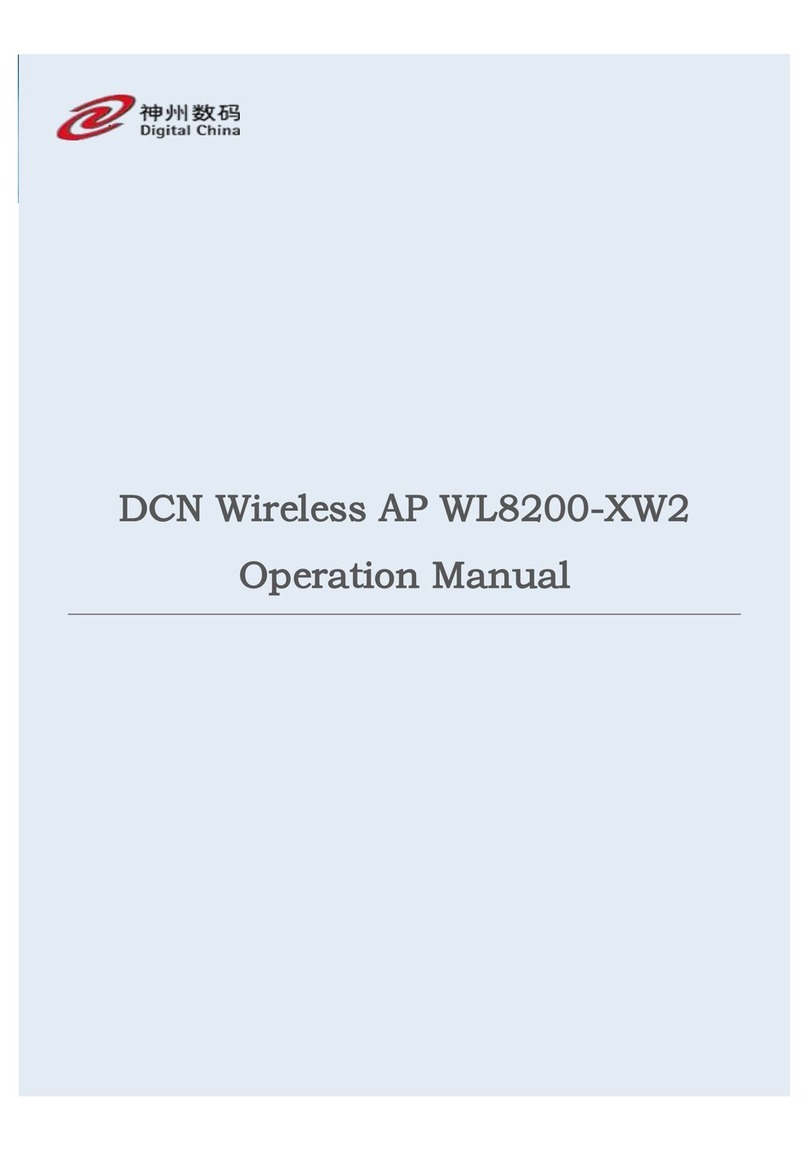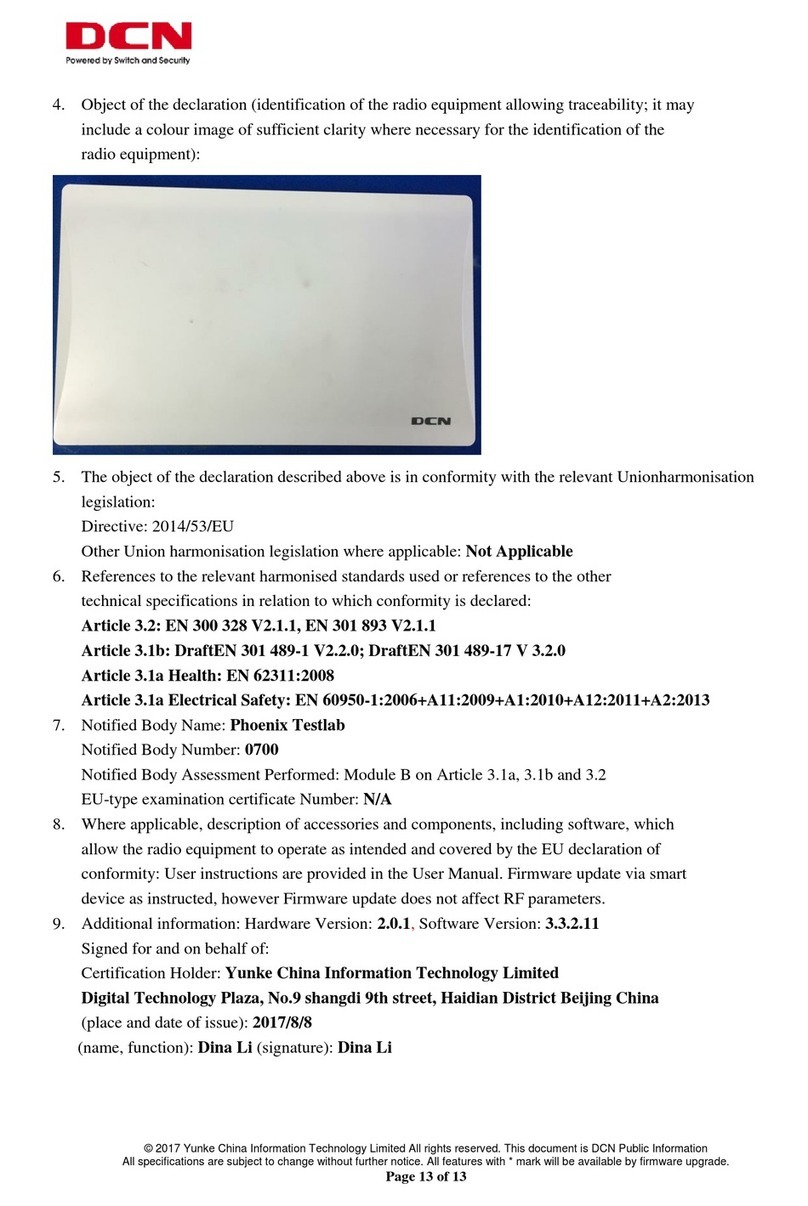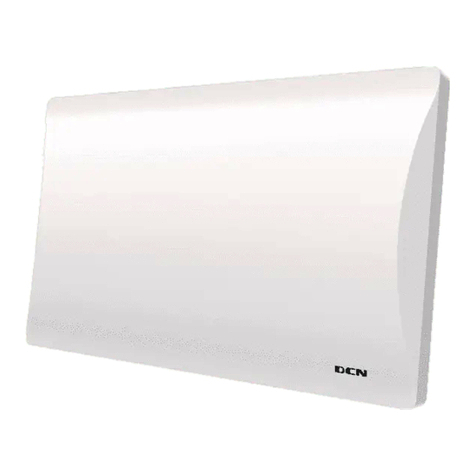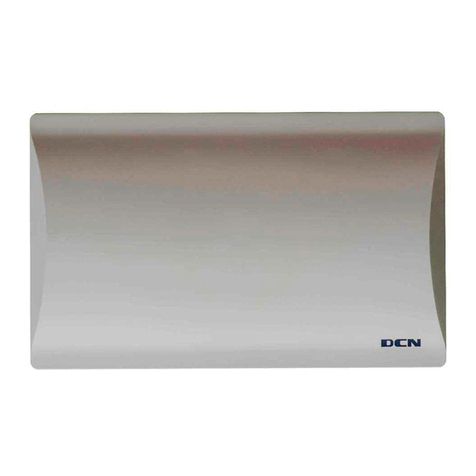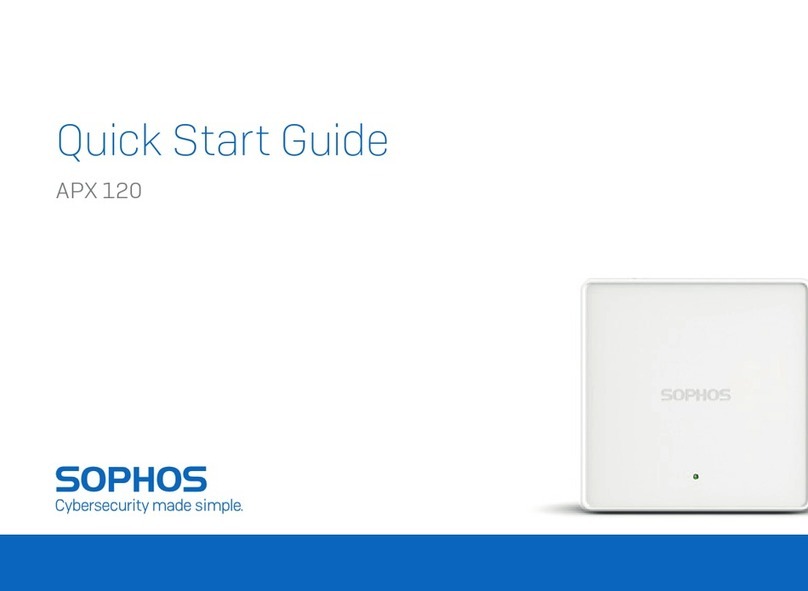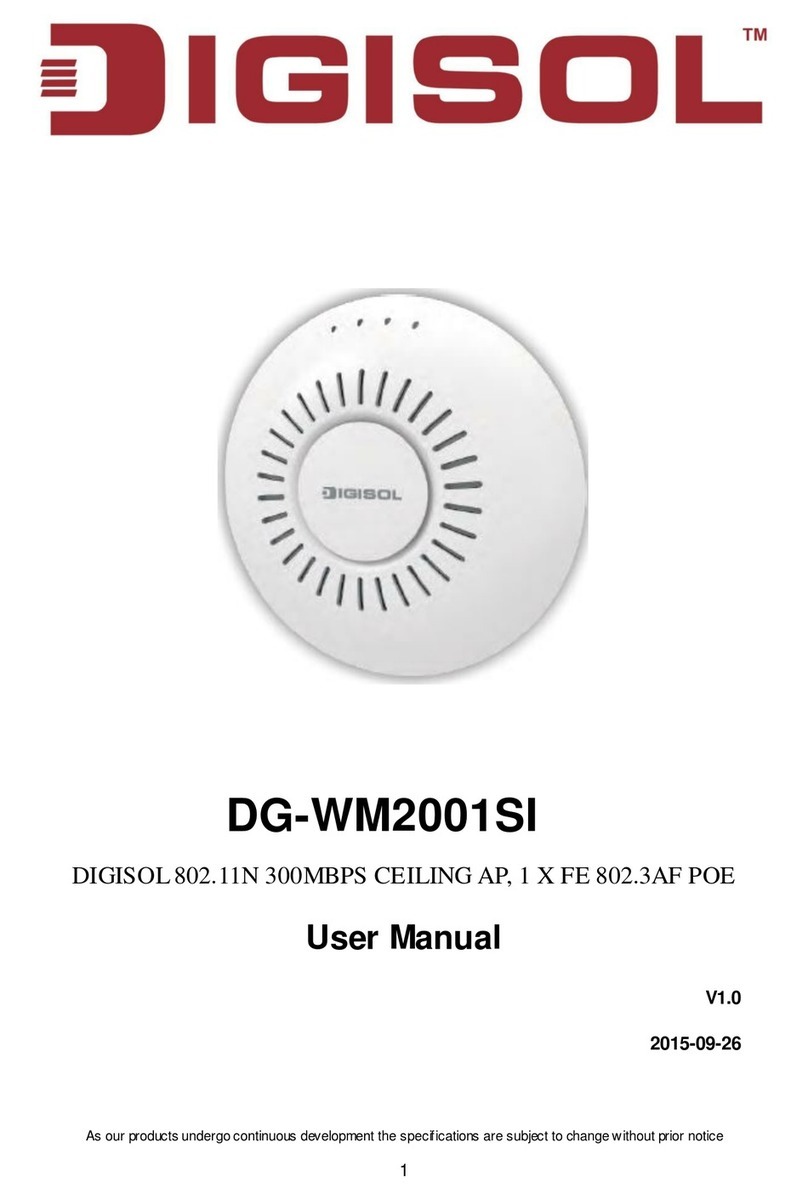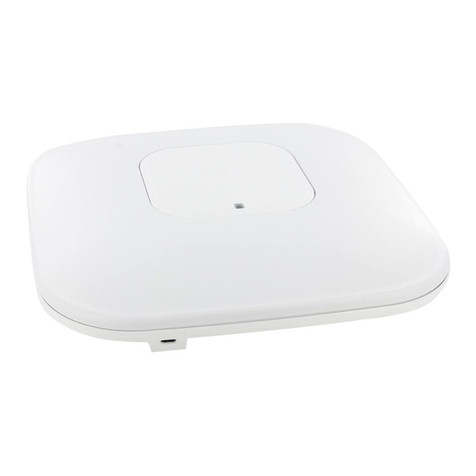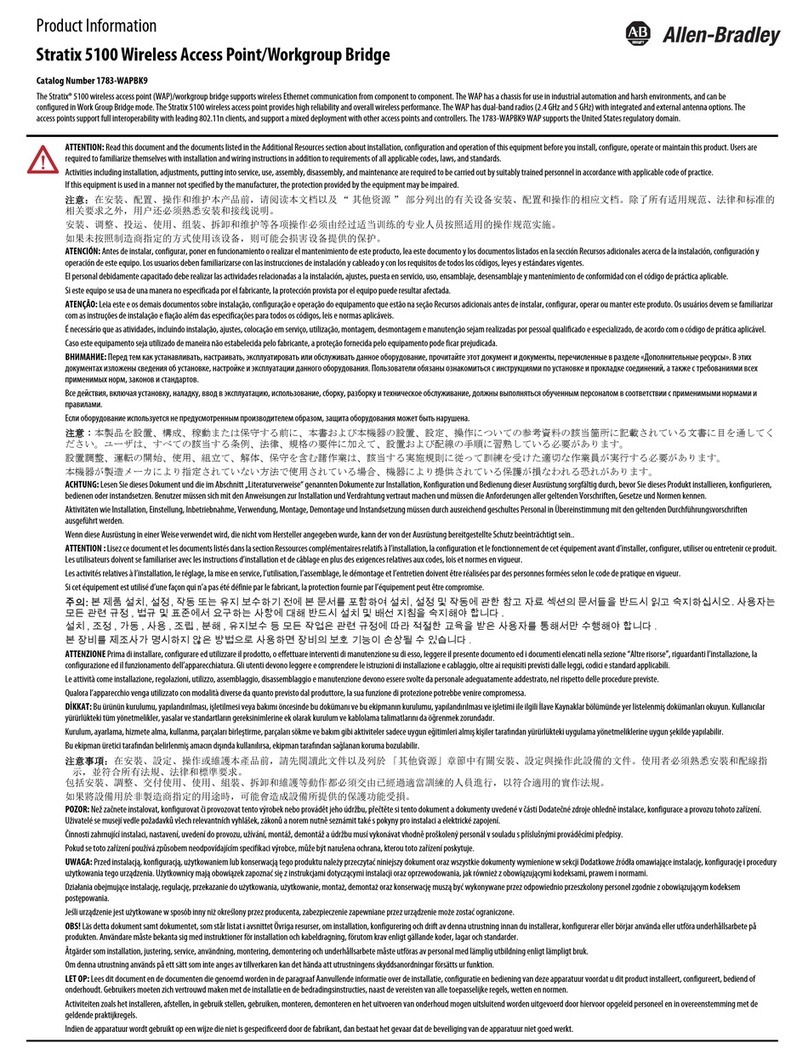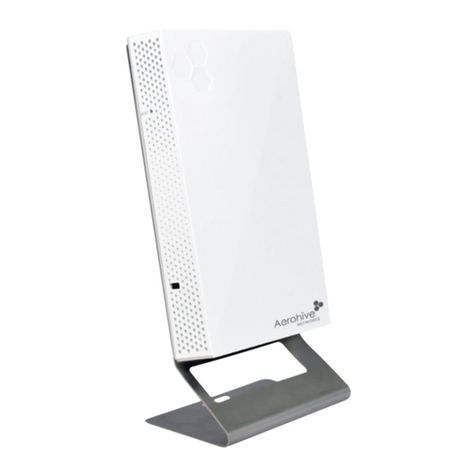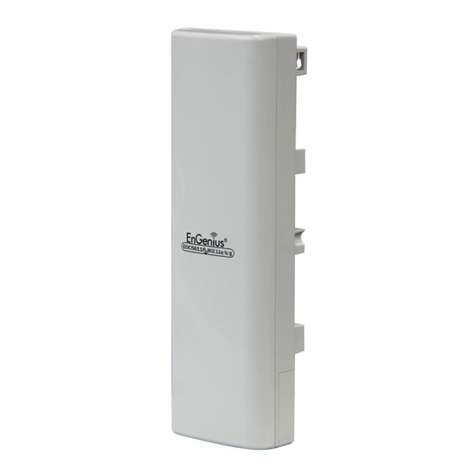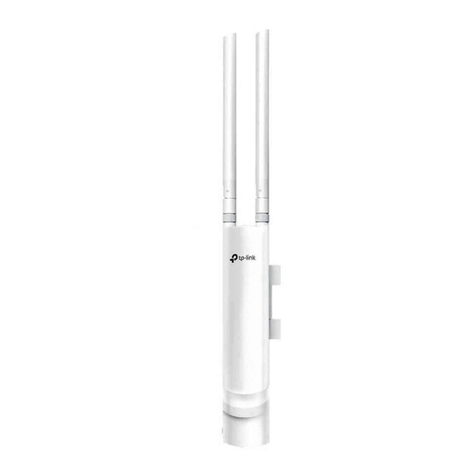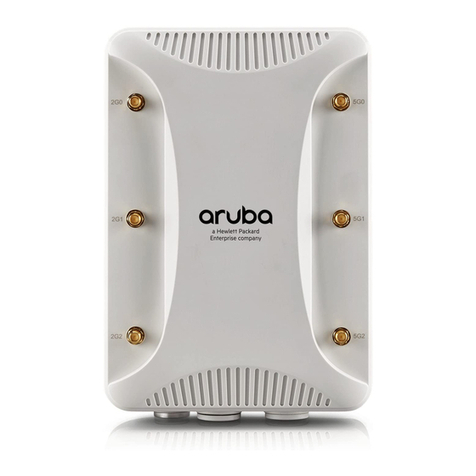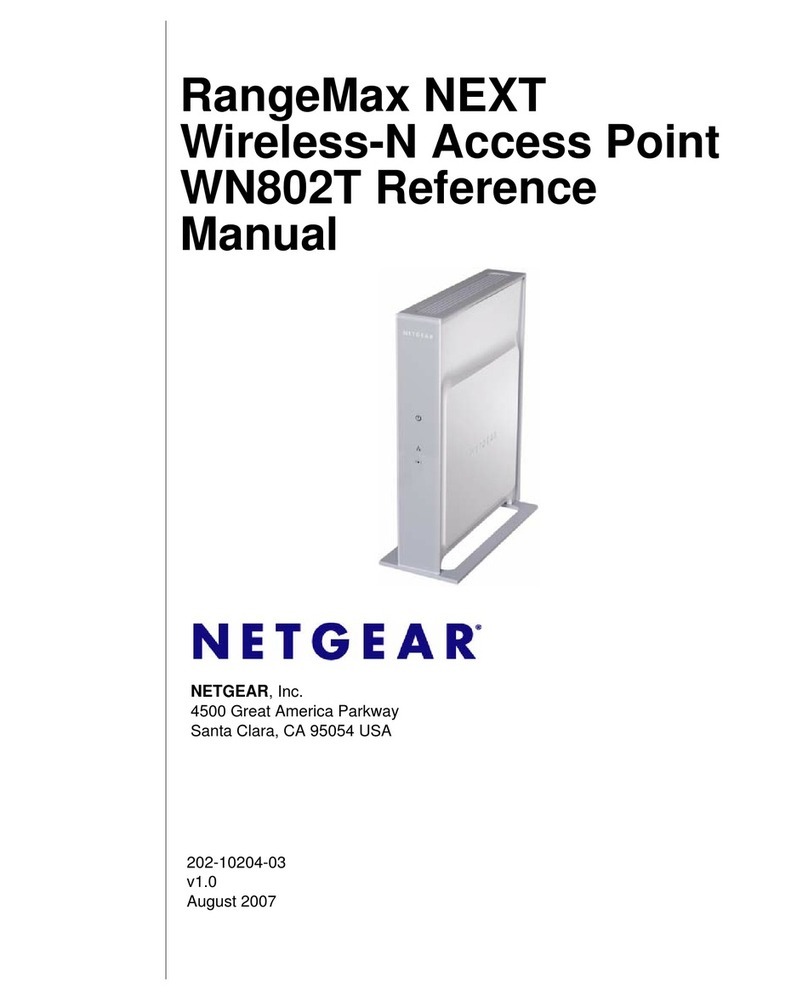DCN EAP280-L Operating and maintenance instructions

Device Port and Indicator
No
Name
Description
1
ETH
Ethernet Port(48V POE)
2
Reset
Reset Button, Press to Restart;
Press more than 5 seconds
reset to factory default
1
Equipment Introduction
21
436 5
No
Name
Description
3
PWR
Light Always On: System Normal
4
WLAN
Light Always On: Wireless enabled
Light Flash: Data is transferring
5
ETH
Light Always On: Wireless
connection stable
Light Flash: Data is transferring
6
Reserved LED
Quick Installation Manual
EAP280-L
AP(1)
Mounting Kit(1)
Mounting Plate(1)
Expansion
Tube(3)
ST4.2X25(3)
M4X30(2)
Quick Installation
Manual(1)
Qualification
Card(1)
Warranty Card(1)
Packing List
Q
u
ick
I
n
st
a
l
l
G
u
id
e
O
u
t
do
or
CP
E
P
ac
ki
n
gLi
s
t
T
h
e
Q
TS2
10
CP
E(
1
)
Pow
er
Ad
a
pt
er(
1
)
Str
a
p
p
i
n
g
Be
lt
(
2
)
Q
ui
c
kIn
s
t
a
l
l
Gu
i
d
e
(
1
)
L
E
D
S
t
a
t
e
P
WR
O
n
:
P
o
w
e
r
U
p
WL
AN
O
n:
Wi
-
F
i
L
i
n
k
B
l
i
nkin
g
:
Da
t
a
T
r
a
ns
mi
t
E
T
H
On:
E
th
er
n
et
L
i
nk
B
l
i
n
k
i
n
g
:
D
a
t
a
T
r
a
n
s
m
it
W
i
r
e
l
e
s
s
RS
S
I
L
E
D
N
o
.
N
a
m
e
D
e
s
c
r
i
p
t
i
on
1
E
TH
E
t
herne
t
P
o
r
t
2
RE
SE
T
Res
e
t
B
ut
t
on,
s
h
or
tpus
h
tos
ys
te
m
re
s
e
t,
a
nd
push
m
o
r
etha
n5
s
ec
o
n
ds
t
o
r
e
s
t
or
e
t
of
a
c
t
o
r
yde
f
a
u
l
t
1
I
n
t
r
od
uc
ti
on
I
nt
e
r
f
a
c
e
P
W
R
W
L
A
NE
T
H
1
2
P
W
R
W
L
A
N
E
T
H
P
W
R
W
L
A
N
E
T
H
DCN Pr oduc ts Warr anty C ard

Wall Mounting
2 3
Please follow the length and width in picture 1, and then use marker pen to mark the drilling
location. is covert security installation is insecurity installation (The figure draw line
downward).
Please use 6mm drill head, drill holes with a depth of 35-40mm according to the marked place.
Plug in the holes with nut and use a hammer to knock the nut.
Put the mounting kit’s hole accurate to nut and use three screw to install mounting kit to the wall.
Put the mounting holes behind of the AP onto the mounting kit’s pegs and then pull the AP
down until copper direction to complete installation.
2
1
3
5
4
Preparing for Installation
2
Equipment Installation
Before installation, installation personnel must take the necessary safety
measures to ensure personal safety
Do not put AP and Tool on walkways to avoid damage
Device support wall mounting and ceiling mounting,make sure the ceiling and walls
can bear safety before installation
Installation may need tools listed on the below picture.(Tools need to self prepared)
AB
5
4
b
a
Ladder
Marker Pen
Hand Driller
Phillips
screwdriver
Claw
Hammer
Please plug in cable before the installation to the wall else after installation, cable cannot be plugged in.
Attention

≤15mm
Ceiling Mount
Take down the ceiling and use 4mm drill to open two hole on ceiling. The distance between
two hole is 40mm.
Use locking slide to screw up sheet metal mount and ceiling. Mounting kit and locking slide
will be put at different side of ceiling and install by using screw.
Put the mounting holes behind of the AP onto the mounting kit’s pegs and then pull the AP
slowly until copper direction to complete installation.
2
1
3
Ceiling mount need to use screws which is 30mm long. It is suitable for 15 mm thick ceiling. When need
to use for thicker ceiling, customers need to prepare for longer screws.
1
2
3
T-keel installation
Use M4 screw to screw up to sliding lock’s hole like above picture and leave 3~5 mm space.
Put mounting kit’s card slot into card slot of the keel.
Put the screw of sliding lock through hoist hole and adjust the position of sliding lock to the other side of
keel.
Finally, screw up the screw so that the mounting kit is fixedly mounted in the T-keel.
Put the mounting holes behind of the AP onto the mounting kit’s pegs and then pull the AP slowly until
copper direction to complete installation.
2
1
3
3~5mm
1
2
3
Ceiling mount need to use covert security installation to prevent AP take off from the mount.
T-keel Installation need to use covert security installation to prevent AP take off from the mount.
5
4
5
4
Attention
Warning
Warning

FCC Notice
Changes or modifications not expressly approved by the party responsible for
compliance could void the user's authority to operate the equipment
NOTE: This equipment has been tested and found to comply with the limits for a
Class B digital device, pursuant to Part 15 of the FCC Rules. These limits are
designed to provide reasonable protection against harmful interference in a
residential installation. This equipment generates, uses and can radiate radio
frequency energy and, if not installed and used in accordance with the instructions,
may cause harmful interference to radio communications. However, there is no
guarantee that interference will not occur in a particular installation. If this equipment
does cause harmful interference to radio or television reception, which can be
determined by turning the equipment off and on, the user is encouraged to try to
correct the interference by one or more of the following measures:
-- Reorient or relocate the receiving antenna.
-- Increase the separation between the equipment and receiver.
-- Connect the equipment into an outlet on a circuit different from that to
which the receiver is connected.
-- Consult the dealer or an experienced radio/TV technician for help.
This device complies with Part 15 of the FCC Rules. Operation is subject to the
following two conditions: (1) this device may not cause harmful interference, and (2)
this device must accept any interference received, including interference that may
cause undesired operation.
When using this product, it should be installed and operated with a minimum distance
of 7.9 in.(20 cm) for 2.4 GHz operations between the radiator and your body. This
transmitter must not be collocated or operate in conjunction with any other antenna
or transmitter.
This equipment complies with FCC radiation exposure limits set forth for an
uncontrolled environment. End users must follow the specific operating instructions
for satisfying RF exposure compliance. This transmitter must not be co-located or
operating in conjunction with any other antenna or transmitter.
Released: Rev 2.0 (1-16-2015)

EAP280-L Indoor Wireless AP

f
EAP280-L
Product Overview
EAP-280-L is new-generation 802.11n-based high-performance
gigabit wireless access points (APs) launched by Digital China
Networks Co., Ltd. (hereinafter referred to as DCN) for industrial
users. It provides a wireless access rate equivalent to at least six
times the rate available on a conventional 802.11a/b/g network,
and offers wider coverage.
While completely taking into consideration important factors,
such as wireless network security, radio frequency (RF) control,
mobile access, quality of service (QoS) guarantee, and seamless
roaming, the EAP280-L may be used with DCN wireless ACs to
perform data forwarding, security, and access control of wireless
users.
The EAP280-L operates in a 2.4 GHz band and employs
technologies such as multiple-input multiple-output (MIMO) and
orthogonal frequency division multiplexing (OFDM), providing a
data transmission rate of at most 300 Mbps .
Featuring exible installation, the EAP280-L may be installed on
the wall, desk top, or ceiling. The EAP280-L supports power over
Ethernet (PoE). The EAP280-L is a series of high-rate wireless
APs preferred in various application environments for purposes
such as campus WLAN access, campus coverage, and ISP' hot
spot coverage.
Highlights
High-Performance and High-Reliability Wireless
Network
► High-speed wireless broadband access
The EAP280-L supports the 802.11bgn standard and provides
an access bandwidth up to 300 Mbps.
► High-Performance RF characteristics
Professional optimized design is employed for the RF module
of the EAP280-L, so that a single antenna port supports 24
dBm transit power at all rate levels, thereby improving wireless
coverage in high-rate access scenarios.
► Automatic emergency mechanism of APs
In a centralized network architecture where fit APs and a wireless
EAP280-L AC are deployed, the APs will be unable to operate normally when
the wireless AC is down and then the entire wireless network
will crash. DCN wireless APs support an automatic emergency
mechanism. This mechanism enables an AP to intelligently detect
links. When detecting that the wireless AC is down, the AP quickly
switches its operating mode so that it may continue to forward
data while enabling new users to access the network. This
mechanism attains high availability in the entire wireless network
and really helps wireless users to be always online
► Broad operating temperature range
Thanks to deliberate hardware design and the selection of
dedicated components operating in a broad temperature
range, DCN smart APs may operate in an environment with its
temperature ranging from 0°C to +50°C
► Dual-OS backup mechanism
DCN smart APs support a dual-OS backup mechanism. When an
AP fails to start from the active OS, it can immediately start from a
standby OS, thereby improving the long-term running reliability of
equipment in an adverse environment.
Wireless Network of Intelligent Control and Automatic
Perception
► Only 11n access control mechanism
Since 802.11n is downward compatible with the 802.11a/b/g
protocol, generally 802.11a/b/g users can also access an 802.11n
wireless access device. When this compatibility is provided,
however, users with 802.11n access capability will experience
performance degradation to a certain extent. On DCN smart APs,
a certain RF channel may be set to only 11n access mode so that
802.11n users have guaranteed bandwidths.
► Intelligent RF management
DCN smart APs may be used with a wireless AC to perform
automatic power and channel adjustment. They employ particular
RF detection and management algorithms to attain a better
RF coverage effect. When the signals of an AP are interfered
by strong external signals, the AP may automatically switch
to an appropriate operating channel under the control of the
AC to avoid such interference, thereby guaranteeing wireless
network communications. The system also supports wireless
network blackhole compensation. When an AP on the network
accidentally stops operating, the RF management function of the
AC compensates the resulting blind area of signals so that the
wireless network can still operate normally.
► Intelligent control of terminals based on airtime
fair
When some outdated 802.11b and 802.11g terminals are used
on a wireless network or some terminals are far way from APs,
negotiation rates will be low, causing a large number of users to
experience a long WLAN access delay, low rates, or poor overall
AP performance. The AP performance problem in a lowrate
terminal access environment, however, cannot be resolved by
simply employing rate control and traffic shaping. DCN smart APs
have essentially resolved this problem by using intelligent control
of terminals based on airtime fairness, ensuring that a user can
always enjoy the same joyful WLAN experience in the same
location, no matter what type of the terminal the user is holding.
The intelligent control of terminals based on airtime fairness
greatly improves the performance of both the client and the entire
network. It enables all clients with high data transmission rates
to attain strikingly higher performance while low-rate clients are
almost not affected at all. The performance will be even more
obviously higher on an open wireless network. Once high-rate
clients finish data transmission, fewer clients will be transmitting
data on the wireless network. In this case, there will be less
contention and retry on the network, thereby greatly improving
overall AP performance.

f
EAP280-L
► Intelligent load balancing mechanism
In general, a wireless client will select an AP according to the
signal strength of APs. When this uncontrolled access mode is
applied, however, a large number of clients could be connected
to the same AP simply because the AP provides strong signals.
As more clients are connected to an AP, the bandwidth available
to each client will be smaller, thereby greatly affecting user
experience of the clients. DCN wireless products support
diversified intelligent load balancing means:
--AP load balancing based on traffic
--AP load balancing based on the number of users
--AP load balancing based on frequency bands
--Access control based on signal strength of terminals
--Mandatory roaming control of terminals to direct terminals to
APs with stronger signals
► Intelligent identification of terminals
DCN smart APs may be used with DCN wireless ACs and a
unified authentication platform to intelligently identify the size,
system type, and type of each terminal; and comprehensively
support mainstream smart terminal operating systems, such as
Apple iOS, Android, and Windows. They intelligently identify the
size of a terminal and adaptively present a portal authentication
page of the corresponding size and page pattern, freeing users
from multiple times of dragging to adjust the screen and enabling
users to enjoy more intelligent wireless experience. They can also
intelligently identify the system type of each terminal and present
the system type of each terminal such as Windows, MAC OS, or
Android on the unified authentication platform, exhibiting every
detail of intelligence to users. In addition, they can intelligently
identify the type of each terminal such as the mobile phone,
tablet, or PC, and implement dynamic policy control of terminals
according to different types of the terminals, making possible
more intelligent user control at a finer granularity.
► Comprehensive support for IPV4/V6 dual-stack
network
Powered by DCN cutting-edge IPv6 technology, DCN smart
APs may be deployed on an IPv6 network, with IPv6 tunnels
established through auto negotiation between a wireless AC and
an AP. When the wireless AC and the AP completely operate
in IPv6 mode, the wireless AC can still correctly identify IPv4
terminals and process IPv4 packets from wireless clients.
Featuring flexible adaptability to IPv4/6, DCN smart APs cater
to complex applications involved in migration from an IPv4
network to an IPv6 network. They not only provide IPv4 service to
customers on an IPv6 network, but also enable users on an IPv4
network to log in to the network through the IPv6 protocol at ease.
► Network-wide seamless roaming
DCN wireless ACs support an advanced wireless AC cluster
technology, which enables multiple ACs to synchronize online
connection information and roaming records of all users to each
other in real time. This technology implements not only L2/L3
seamless roaming inside a wireless AC but also fast roaming
across wireless ACs. As client IP address information does not
change and re-authentication is not required in the roaming
process, the continuity of real-time mobile services is well
guaranteed.
Secure and Controllable Wireless Network
► User isolation policy
DCN wireless APs support the isolation of wireless users from
one another. If this user isolation function is enabled, two wireless
clients cannot directly communicate with each other but can only
access an upstream wired network. This further guarantees the
security of wireless network applications.
► Wireless intrusion detection and intrusion defense
DCN wireless APs support wireless intrusion detection and
intrusion defense features, such as detection of unauthorized
wireless devices, intrusion detection, blacklist, and white list,
thereby greatly improving security management of an entire
wireless network.
► Wireless user management at a fine granularity
Each AP supports a maximum of 16 WLANs to implement
multilayer multi-service management of wireless users at a
fine granularity. Each WLAN supports access control and uplink/
downlink rate limit based on MAC or IP addresses. These
WLANs may be bound to virtual local area networks (VLANs). In
addition, different authentication and accounting policies can be
implemented. This feature is practically significant in a multiWLAN
environment.
► Secure user admission
DCN smart APs may be used with wireless ACs to provide multiple
secure access, authentication, and accounting mechanisms for
various application environments. These mechanisms include:
--802.1x authentication
--Captive portal authentication, including built-in portal, external
portal, and custom portal authentication modes
--MAC address authentication
--LDAP authentication
--WAPI encryption and authentication
--Wired/wireless integrated authentication and accounting
► Wireless SAVI
DCN wireless network products support a source address
validation (SAVI) technology to deal with spoofed packet attacks
that keep emerging on today's campus networks. As users' IP
addresses are obtained through an address allocation protocol,
users access the Internet using correct addresses in subsequent
applications and cannot spoof others' IP addresses, thereby
guaranteeing the reliability of source addresses. In addition, the
SAVI technology is combined with a portal technology to further
guarantee the authenticity and security of packets of all users
accessing the Internet.
► PEAP user authentication
With the popularization and application of smart terminals,
wireless terminal users require authentication mechanisms
of higher usability and convenience. Using a mechanism that
combines portal authentication and MAC address authentication,
DCN wireless network products support Protected Extensible
Authentication Protocol (PEAP) authentication to attain better
user experience. Initially a user needs to manually perform portal
authentication and later the user gets authenticated through PEAP
in automatic mode. DCN wireless network products feature high
terminal adaptation and provide good authentication compatibility.
They adapt to the majority of WLAN terminals and do not need to
adapt to clients. DCN wireless network products are compatible
with existing portal authentication modes.
► Secure access mechanism
An AP is usually deployed in a public area and therefore requires
a strict security mechanism to guarantee the legality of access
devices. The following secure access mechanisms may be
applied between a DCN smart AP and a wireless AC:
--AP MAC address authentication
--AP password authentication
--Bidirectional digital certificate authentication

f
EAP280-L
► Real-time spectrum protection
DCN smart APs support a built-in RF collection module that
integrates RF monitoring and real-time spectrum protection.
By implementing communications and data collection through
the respective AP, the RF collection module performs wireless
environment quality monitoring, wireless network capability
tendency evaluation, and unexpected-interference alarms. It
resorts to a graphical means to actively detect and identify RF
interference sources (Wi-Fi or non-Wi-Fi) and provides a realtime
spectrum analysis diagram. In addition, it can automatically
identify interference sources and determine the locations of
problematic wireless devices, ensuring that a wireless network
attains optimal performance.
Easy-to-Manage Wireless Network
► Plug-and-play
DCN smart APs are able to automatically discover DCN wireless
ACs. A wireless network function can be enabled on an AP
without performing any configuration on the AP at all. The AP
can be seamlessly integrated with existing switches, firewalls,
authentication servers, and other network devices without
changing existing network architecture.
When used with a DCN wireless AC, DCN smart APs support
plug-and-play and zero configuration. The wireless AC undertakes
all the management, control, and configuration of the APs.
Network administrators do not need to separately manage or
maintain a huge number of wireless APs. All actions, such as
Item EAP280-L
Dimensions (mm) 195(length) 195(width) 45(height)
10/100 Base-T 1
PoE 802.3af
Working frequency band 802.11b/g/n : 2.412GHz-2.462GHz (USA)
Modulation technology
OFDM:BPSK@6/9Mbps,QPSK@12/18Mbps,16-QAM@24Mbps,64-QAM@48/54Mbps
DSSS:DBPSK@1Mbps,DQPSK@2Mbps,[email protected]/11Mbps
MIMO-OFDM:MCS 0-15
Transmit power The maximum transmit power output is 24dBm
Power adjustment
granularity 1 dBm
AP access rate
802.11n:
20MHz BW: 6,5, 7.2, 13, 14.4, 19.5, 21.7, 26, 28.9, 39, 43.3, 52, 57.8, 58.5, 65, 72.2, 78, 86.7, 104,
115.6, 117, 130, 144Mbps
40MHz BW: 13.5, 15, 27, 30, 40.5, 45, 54, 60, 81, 91, 108, 120, 121.5, 135, 140, 150, 162, 180, 216,
240, 243, 270, 300Mbps
802.11g: 54, 48, 36, 24, 18, 12, 11, 9, 6, 5.5, 2, 1Mbps
802.11b: 11, 5.5, 2, 1Mbps
Working/Storage
temperature 0°C~50°C/-40°C~85°C
Working/Storage RH 5% to 95% (no condensing)
Protection level IP21
FR standard Radio Transmission Equipment Type Approval Certicate issued by the Ministry of Industry and
Information Technology of P. R. China
Hardware Specifications
configuration, firmware upgrade, and security policy updating, are
performed uniformly under the control of the wireless AC.
► Fit and Fat modes
DCN smart APs may work in fit or fat mode and can flexibly
switch between the fit mode and the fat mode according to
network planning requirements. Users may also flexibly choose
an ex-factory device version according to specific application
requirements. APs working in fit mode are managed by a wireless
AC in a centralized manner. System administrators may easily
manage the entire network as the states of all the APs are clear at
a glance.
► Automatic AP version upgrade
DCN smart APs may be automatically associated with a wireless
AC on the live network to automatically download a latest software
version and get automatically upgraded, thereby reducing the
workload during network maintenance.
► Remote probe analysis
DCN smart APs support a remote probe analysis function,
which listens to and captures Wi-Fi packets in the coverage
and mirrors them to a local analysis device in real time to
help network administrators better perform troubleshooting or
optimization analysis. The remote probe analysis function can
perform nonconvergence mirroring of a working channel and
sampling of all channels in polling mode as well to flexibly meet
various wireless network monitoring, operation, and maintenance
requirements.
Product Specications

f
EAP280-L
Software Specifications
Item Feature EAP280-L
WLAN
Product positioning Indoor single-frequency
Working frequency band 2.4 GHz
Maximum number of access users 127
Virtual AP (BSSID) 16
Number of spatial streams 2
Dynamic channel adjustment (DCA) Yes
Transmit power control (TPC) Yes
Blind area detection and repair Yes
SSID hiding Yes
RTS/CTS Yes
RF environment scanning Yes
Hybrid access Yes
Restriction on the number of access
users Yes
Link integrity check Yes
Prohibiting the access of terminals
with weak signals Yes
Forced roaming of terminals with
weak signals Yes
Intelligent control of terminals based
on airtime fairness Yes
High-density application optimization Yes
11n enhancements
40 MHz bundling Yes
300 Mbps (PHY) Yes
Frame aggregation (A-MPDU) Yes
Maximum likelihood demodulation
(MLD) Yes
Transmit beam forming (TxBF) Yes
Maximum ratio combining (MRC) Yes
Space-time block coding (STBC) Yes
Low-density parity-check code
(LDPC) Yes

f
EAP280-L
Item Feature EAP280-L
Security
Encryption 64/128 WEP, dynamic WEP, TKIP, and CCMP encryption
802.11i Yes
WAPI Yes
MAC address authentication Yes
LDAP authentication Yes
PEAP authentication Yes
WIDS/WIPS Yes
Real-time spectrum protection Yes
Protection against DoS attacks Anti-DoS for wireless management packets
Forwarding security Frame ltering, white list, static blacklist, and dynamic blacklist
User isolation AP L2 forwarding suppression
Periodic SSID enabling and disabling Yes
Access control of free resources Yes
Secure admission control of wireless
terminals Secure admission control of wireless terminals based on DCSM
Wireless SAVI Yes
ACL Access control of various data packets such as MAC, IPv4, and IPv6
packets
Secure access control of APs
Secure access control of APs, such as MAC authentication,
password authentication, or digital certicate authentication between
an AP and an AC
Forwarding
IP address setting Static IP address conguration or dynamic DHCP address allocation
IPv6 forwarding Yes
IPv6 portal Yes
Local forwarding Yes
Multicast IGMP Snooping
Roaming Fast roaming across APs or ACs
AP switching reference Signal strength, bit error rate, RSSI, S/N, whether neighboring APs
are normally operating, etc.
WDS Yes

f
EAP280-L
Item Feature EAP280-L
QoS
WMM Yes
Priority mapping Ethernet port 802.1P identication and marking
Mapping from wireless priorities to wired priorities
QoS policy mapping
Mapping of different SSIDs/VLANs to different QoS policies
Mapping of data streams that match with different packet fields to
different QoS policies
L2-L4 packet ltering and ow
classication Yes: MAC, IPv4, and IPv6 packets
Load balance
Load balancing based on the number of users
Load balancing based on user trafc
Load balancing based on frequency bands
Bandwidth limit
Bandwidth limit based on APs
Bandwidth limit based on SSIDs
Bandwidth limit based on terminals
Bandwidth limit based on specic data streams
Power saving mode Yes
Automatic emergency mechanism of
APs Yes
Intelligent identication of terminals Yes
Multicast enhancement Multicast to unicast
Management
Network management Centralized management through an AC; both t and fat modes
Maintenance mode Both local and remote maintenance
Logging Local logs, Syslog, and log le export
Alarming Yes
Fault detection Yes
Statistics Yes
Switching between the fat and fit
modes
AP working in t mode can switch to the fat mode through a wireless
AC; AP working in fat mode can switch to the t mode through a local
control port or Telnet.
Remote probe analysis Yes
Dual-image (dual-OS) backup
mechanism Yes
Watchdog Yes
Ordering Information
Product Model Description Remarks
EAP280-L
802.11n indoor wireless AP, provides an access bandwidth up to 300 Mbps
(2.4 GHz single-channel single-frequency, built-in antenna, 802.3af PoE)
(PoE module need to be separately purchased.Don’t support local power)
Mandatory
DCWL-PoEINJ-G+ 10/100/1000 Mbps 1-port 802.3at PoE module Optional
Contact us
Digital China Networks Limited
For more detail information about DCN product, contact:
URL: http://www.dcnglobal.com
Email: [email protected]
Address: Digital Technology Plaza, NO.9 Shangdi 9th Street, Haidian District, Beijing, China
Table of contents
Other DCN Wireless Access Point manuals
Popular Wireless Access Point manuals by other brands
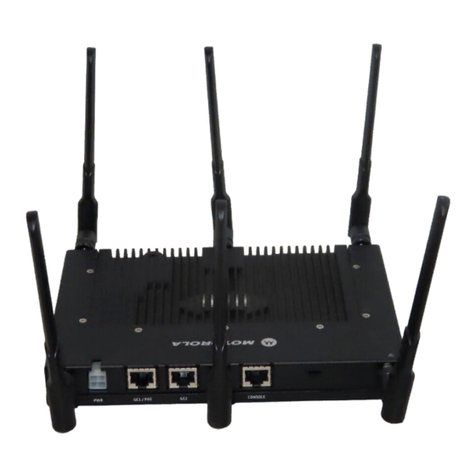
Motorola
Motorola P-7131N-FGR Product reference guide

Microsens
Microsens MS659150M quick start guide

Ubiquiti
Ubiquiti UniFi UAP-AC-LITE quick start guide
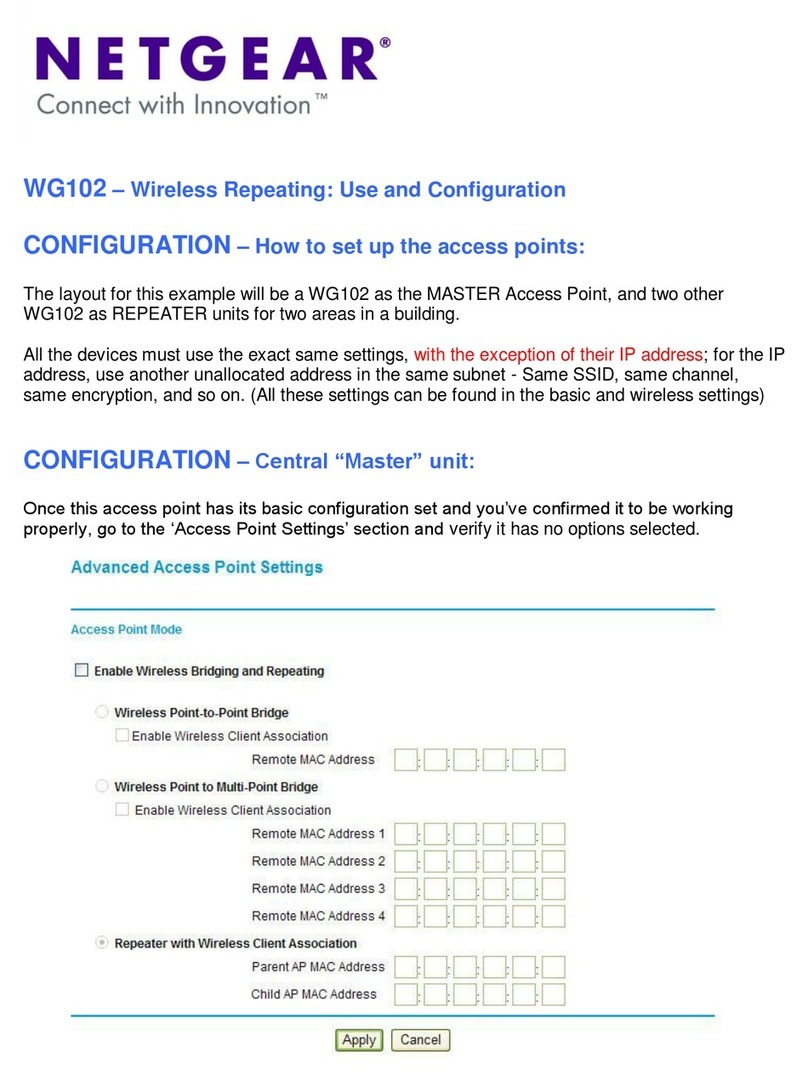
NETGEAR
NETGEAR WG102 - ProSafe Wireless Access Point Configuration guide
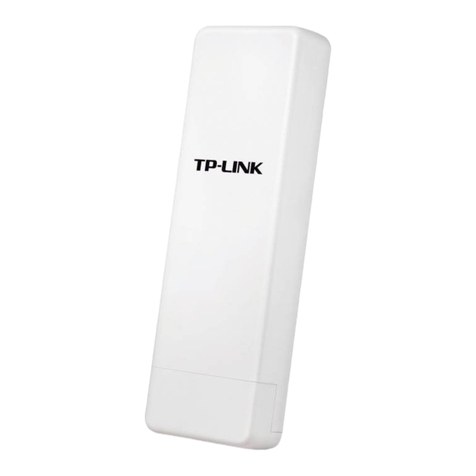
TP-Link
TP-Link TL-WA7510N user guide
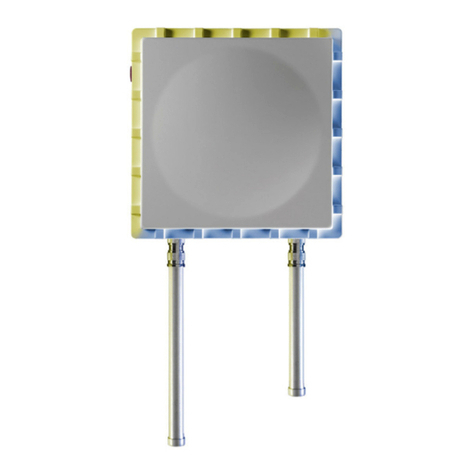
Proxim
Proxim ORiNOCO AP-4000MR-LR Quick install guide

